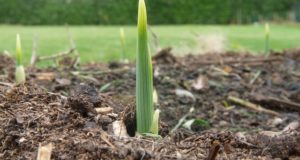“No dig” gardening is an easy way to organically grow your own fresh veggies, no matter where you build your bed. This type of garden plot can be built almost anywhere in a few hours and will require little to no on-going maintenance. It is similar to “lasagna gardening,” but doesn’t require the layers to be decomposed before planting the beds. It is said to be the “quickest, easiest way” to grow your own organic vegetables.
 Equipment
Equipment
- Gravel – if necessary for drainage
- Newspaper and large buckets of water for soaking them
- One or two bales pea straw [or lucerne]
- Compost
- Manure
- One or two bales of coarse straw or mulch
Designing
You will want to put your garden in an area that gets at least six hours of full sunshine daily. There is no reason to build a frame for your no-dig garden, as they tend to hold themselves together. But if you have some boards or other material that you want to use to define its boundaries, feel free to build the frame in the shape you choose. Some have used old railroad ties or re-used old lumber to frame their garden plots. When deciding on the size of your beds, you will need to consider how far you can reach. You will want to be able to reach at least half way across the bed for ease in planting and caring for your plants. I prefer beds no wider than three feet across. The length of your beds will depend on the size of the area you will be using for the garden. I like to have my beds seven to nine feet in length with at least two feet between the beds to allow room for weeding, planting, and fertilizing your garden area. However, the size and shape of your garden beds is only limited by your imagination.
Deciding on the layout will depend on what you are growing and the various heights and the relationship—beneficial or harmful – the plants will have on each other. Taller plants should be put on the west side of shorter crops to allow for maximum sunshine. Beans and corn do well side by side as they are beneficial to one another.
Construction
- Base – Start with a flat surface. If necessary, cut down any weeds, leave them where they lay to decompose. Place a layer of gravel an inch or two thick down first to allow drainage, if problems exist.
- Newspaper – Soak the newspaper in the buckets of water until wet through. Lay them out in the garden area overlapping them as you go. Newspaper inhibits the growth of weeds in your garden and is biodegradable, too – remember we do not want to use any glossy newsprint, as the chemicals in their ink will leach into the grown and may be harmful. The layer of newspaper should be six- to eight-pages thick.
- Pea straw, compost, and manure – It is time to alternate layers of fine and coarse vegetation and manure. Start with a layer of pea straw [or fine straw]. Next lay out a thin layer of manure followed by a layer of compost. Repeat these layers until you run out of materials or until the garden area is at least 12 inches high, finishing with a thick layer of compost.
- Cover the whole area with a deep layer of straw or other mulch.
- Planting – You can start your plants from seed in trays or buy your plants from your garden center or home improvement store. When it is time to put them in the ground, push aside some of the mulch, dig small holes with your trowel, and add some potting mix to the holes. Place the plants in the holes, water well and replace the mulch around the plants. Keep a thick layer of mulch around your plants to keep them cool and moist in the heat of summer.
- Watering – Water at least once daily. In very dry climates you will want to water twice daily. The best time for watering your garden is between 6:00 pm and 10:00 am. Living in a high desert region, I water twice daily – 6 to 10 am and 6 to 10 pm. Watering should not be done after 10:00 am or before 6:00 pm as it will evaporate more quickly during the heat of the day and will leave your plants thirsty and dry. This will cause poor plant development and yield a smaller harvest.
- After Harvest – When you have picked the fruit of your harvest you can start preparing for next year. Cover your garden area with a thick layer of manure and then an equally thick layer of mulch or hay.
Build, plant, and enjoy the fruit of your labors. Happy Gardening!
 Off The Grid News Better Ideas For Off The Grid Living
Off The Grid News Better Ideas For Off The Grid Living




